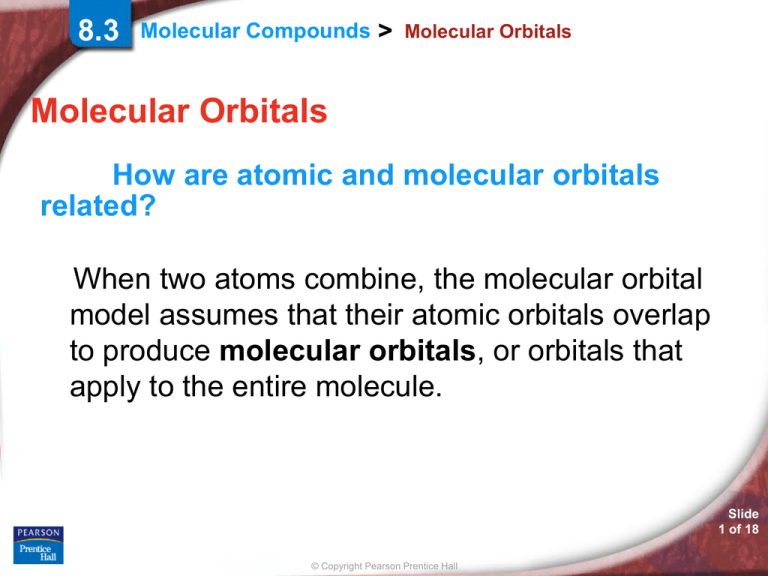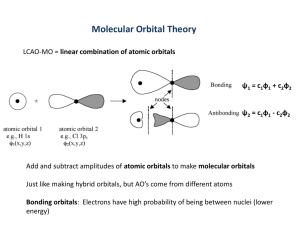
8.3
Molecular Compounds > Molecular Orbitals
Molecular Orbitals
How are atomic and molecular orbitals
related?
When two atoms combine, the molecular orbital
model assumes that their atomic orbitals overlap
to produce molecular orbitals, or orbitals that
apply to the entire molecule.
Slide
1 of 18
© Copyright Pearson Prentice Hall
8.3
Bonding Theories > Molecular Orbitals
Just as an atomic orbital belongs to a
particular atom, a molecular orbital
belongs to a molecule as a whole.
A molecular orbital that can be occupied by two
electrons of a covalent bond is called a bonding
orbital.
Slide
2 of 28
© Copyright Pearson Prentice Hall
8.3
Bonding Theories > Molecular Orbitals
Sigma Bonds
When two atomic orbitals combine to form a
molecular orbital that is symmetrical around the
axis connecting two atomic nuclei, a sigma
bond is formed.
Slide
3 of 28
© Copyright Pearson Prentice Hall
8.3
Bonding Theories > Molecular Orbitals
A Sigma Bond
Slide
4 of 28
© Copyright Pearson Prentice Hall
8.3
Bonding Theories > Molecular Orbitals
When two fluorine atoms combine, the p orbitals
overlap to produce a bonding molecular orbital.
The F—F bond is a sigma bond.
Slide
5 of 28
© Copyright Pearson Prentice Hall
8.3
Bonding Theories > Molecular Orbitals
Pi Bonds
In a pi bond (symbolized by the Greek letter ),
the bonding electrons are most likely to be found
in sausage-shaped regions above and below the
bond axis of the bonded atoms.
Slide
6 of 28
© Copyright Pearson Prentice Hall
8.3
Bonding Theories > Molecular Orbitals
Pi-bonding Molecular Orbital
Slide
7 of 28
© Copyright Pearson Prentice Hall
8.3
Bonding Theories > VSEPR Theory
VSEPR Theory
How does VSEPR theory help predict
the shapes of molecules?
Slide
8 of 28
© Copyright Pearson Prentice Hall
8.3
Bonding Theories > VSEPR Theory
The hydrogens in a methane molecule are at
the four corners of a geometric solid. All of the
H—C—H angles are 109.5°, the tetrahedral
angle.
Slide
9 of 28
© Copyright Pearson Prentice Hall
8.3
Bonding Theories > VSEPR Theory
The valence-shell electron-pair repulsion theory,
or VSEPR theory, explains the threedimensional shape of methane.
According to VSEPR theory, the repulsion
between electron pairs causes molecular
shapes to adjust so that the valenceelectron pairs stay as far apart as possible.
Slide
10 of 28
© Copyright Pearson Prentice Hall
8.3
Bonding Theories > VSEPR Theory
The measured H—N—H bond angle is only
107°.
Slide
11 of 28
© Copyright Pearson Prentice Hall
8.3
Bonding Theories > VSEPR Theory
The measured bond angle in water is about
105°.
Slide
12 of 28
© Copyright Pearson Prentice Hall
8.3
Bonding Theories > VSEPR Theory
The carbon dioxide molecule is linear.
Slide
13 of 28
© Copyright Pearson Prentice Hall
8.3
Bonding Theories > VSEPR Theory
Nine Possible Molecular Shapes
Slide
14 of 28
© Copyright Pearson Prentice Hall
8.3
Bonding Theories > Hybrid Orbitals
Hybrid Orbitals
Orbital hybridization provides
information about both molecular
bonding and molecular shape.
In hybridization, several atomic orbitals
mix to form the same total number of
equivalent hybrid orbitals.
Slide
15 of 28
© Copyright Pearson Prentice Hall
8.3
Bonding Theories > Hybrid Orbitals
Hybridization Involving Single Bonds
Slide
16 of 28
© Copyright Pearson Prentice Hall
8.3
Bonding Theories > Hybrid Orbitals
Hybridization Involving Double Bonds
Slide
17 of 28
© Copyright Pearson Prentice Hall
8.3
Bonding Theories > Hybrid Orbitals
Hybridization Involving Triple Bonds
Slide
18 of 28
© Copyright Pearson Prentice Hall
Bonding Theories >
Bond Polarity
Slide
19 of 28
© Copyright Pearson Prentice Hall
8.4
Bonding Theories > Bond Polarity
Bond Polarity
How do you determine the charge
distribution in a polar bond?
When the atoms in a bond pull equally (as
occurs when identical atoms are bonded), the
bonding electrons are shared equally, and the
bond is a nonpolar covalent bond.
Slide
20 of 28
© Copyright Pearson Prentice Hall
8.4
Bonding Theories > Bond Polarity
The bonding pairs of electrons in covalent bonds
are pulled by the nuclei.
Slide
21 of 28
© Copyright Pearson Prentice Hall
8.4
Bonding Theories > Bond Polarity
The chlorine atom attracts the electron cloud
more than the hydrogen atom does.
Slide
22 of 28
© Copyright Pearson Prentice Hall
8.4
Bonding Theories > Bond Polarity
A polar covalent bond, known also as a polar
bond, is a covalent bond between atoms in which
the electrons are shared unequally.
• The more electronegative atom attracts
electrons more strongly and gains a slightly
negative charge. The less electronegative
atom has a slightly positive charge.
Slide
23 of 28
© Copyright Pearson Prentice Hall
8.4
Bonding Theories > Bond Polarity
Slide
24 of 28
© Copyright Pearson Prentice Hall
8.4
Bonding Theories > Polar Molecules
Polar Molecules
In a polar molecule, one end of the molecule is
slightly negative and the other end is slightly
positive.
A molecule that has two poles is called a dipolar
molecule, or dipole.
What happens to polar molecules between a
pair of oppositely charged metal plates?
Slide
25 of 28
© Copyright Pearson Prentice Hall
8.4
Bonding Theories > Polar Molecules
A hydrogen chloride molecule is a dipole.
Slide
26 of 28
© Copyright Pearson Prentice Hall
8.4
Bonding Theories > Attractions Between Molecules
Attractions Between Molecules
What are intermolecular attractions &
how do they compare with ionic and
covalent bonds?
Slide
27 of 28
© Copyright Pearson Prentice Hall
8.4
Bonding Theories > Attractions Between Molecules
Intermolecular attractions are weaker than either
ionic or covalent bonds.
• These attractions are responsible for
determining whether a molecular compound is
a gas, a liquid, or a solid at a given
temperature.
• Van der Waals Forces & Hydrogen bonding
Slide
28 of 28
© Copyright Pearson Prentice Hall
8.4
Bonding Theories > Attractions Between Molecules
Van der Waals Forces
The two weakest attractions between molecules
are collectively called van der Waals forces,
named after the Dutch chemist Johannes van
der Waals (1837–1923).
Slide
29 of 28
© Copyright Pearson Prentice Hall
8.4
Bonding Theories > Attractions Between Molecules
Dipole interactions
occur when polar
molecules are
attracted to one
another.
Slide
30 of 28
© Copyright Pearson Prentice Hall
8.4
Bonding Theories > Attractions Between Molecules
Dispersion forces, the weakest of all molecular
interactions, are caused by the motion of
electrons.
The strength of dispersion forces generally
increases as the number of electrons in a
molecule increases.
Slide
31 of 28
© Copyright Pearson Prentice Hall
8.4
Bonding Theories > Attractions Between Molecules
Hydrogen Bonds
Hydrogen bonds are attractive forces in which
a hydrogen covalently bonded to a very
electronegative atom is also weakly bonded to
an unshared electron pair of another
electronegative atom.
Slide
32 of 28
© Copyright Pearson Prentice Hall
8.4
Bonding Theories > Attractions Between Molecules
Hydrogen Bonding in Water
Slide
33 of 28
© Copyright Pearson Prentice Hall
8.4
Bonding Theories > Attractions Between Molecules
The relatively strong attractive forces between
water molecules cause the water to form small
drops on a waxy surface.
Slide
34 of 28
© Copyright Pearson Prentice Hall
8.4
Bonding Theories > Intermolecular Attractions and Molecular
Properties
Intermolecular Attractions and Molecular
Properties
Network solids (or network crystals) are
solids in which all of the atoms are covalently
bonded to each other.
Network solids consist of molecules that do
not melt until the temperature reaches
1000°C or higher, or they decompose
without melting at all.
Slide
35 of 28
© Copyright Pearson Prentice Hall
8.4
Bonding Theories > Intermolecular Properties and Molecular
Properties
Melting a network solid would require breaking
covalent bonds throughout the solid.
Slide
36 of 28
© Copyright Pearson Prentice Hall
8.4
Bonding Theories > Intermolecular Attractions and Molecular
Properties
Diamond is an example of a network solid.
Diamond does not melt. It vaporizes to a gas at
3500°C or above.
Slide
37 of 28
© Copyright Pearson Prentice Hall
8.4
Bonding Theories > Intermolecular Attractions and Molecular
Properties
Slide
38 of 28
© Copyright Pearson Prentice Hall






